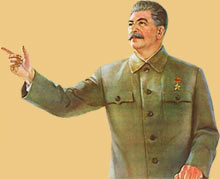 Josef
Stalin Josef
Stalin
Soviet leader Josef Dzhugashvili "Stalin"
(1879-1953) was a brutal Dictator of the Soviet Union from the
1920's to his death in 1953. He was considered one of the most
ruthless leaders in history.
He was the longtime ruler who more than any other individual
molded the features that characterized the Soviet regime and
shaped the direction of Europe following the end of World
War II in 1945.
He was born on December 21, 1879 in Gori, Georgia. His
parents were both Georgian peasants. Although neither of them
spoke Russian, Stalin was forced to learn it because it was
the language of instruction at the Gori church school that he
attended in 1888-94. He was the best student in the school and
earned a full scholarship to the Tbilisi Theological Seminary.
While he studied the priesthood, Stalin read forbidden
literature, including Karl Marx's "Das Kapital", and
soon converted to a new orthodoxy: Russian Marxism. Before
graduation he quit the seminary to become a full-time revolutionary.
Stalin began his career in the Social-Democratic party
in 1899 as a propagandist among Tbilisi railroad workers. The
police caught up with him in 1902. Arrested in Batum, he spent
more than a year in prison before being exiled to Siberia, from
which he escaped in 1904.
|
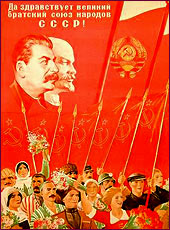 Between
1902 and 1913 Stalin was arrested eight times; he was exiled
seven times and escaped six times. The government contained
him only once; his last exile in 1913 lasted until 1917. He
adopted the pseudonym Stalin, meaning "a man of steel"
during this time. By taking on a Russian name, it was a
way of disassociating himself with his Georgian heritage. Stalin
had a disrespect and hatred for the weak, and Georgia had always
been occupied by another nation, meaning that it was weak for
never being able to be independent. Between
1902 and 1913 Stalin was arrested eight times; he was exiled
seven times and escaped six times. The government contained
him only once; his last exile in 1913 lasted until 1917. He
adopted the pseudonym Stalin, meaning "a man of steel"
during this time. By taking on a Russian name, it was a
way of disassociating himself with his Georgian heritage. Stalin
had a disrespect and hatred for the weak, and Georgia had always
been occupied by another nation, meaning that it was weak for
never being able to be independent.
On his return from Siberia in 1904 Stalin married Ekaterina
Svanidze. His first wife, not only had the same first name as
his mother, but she resembled her in appearance as well. Soon
after son Yakov's birth, Ekaterina became ill and died in 1909.
|
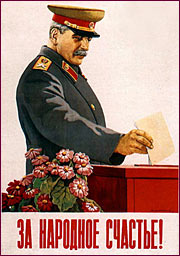 A
second wife, Nadezhda Alliluyeva, whom he married in 1919, committed
suicide in 1932. A
second wife, Nadezhda Alliluyeva, whom he married in 1919, committed
suicide in 1932.
In the last years of czarist Russia (1905-17) Stalin
was more of an up-and-coming follower than a leader. He always
supported the Bolshevik faction of the party, but his contribution
was practical, not theoretical. Thus, in 1907 he helped organize
a bank holdup in Tbilisi "to expropriate" funds. Lenin
raised him into the upper reaches of the party in 1912 by co-opting
him into the Bolsheviks' Central Committee.
As the Bolsheviks' expert on nationalism, Stalin was
Lenin's choice to head the Commissariat for Nationality Affairs.
As Stalin converted this organizational base into a source of
political power, he came into conflict with Lenin on several
minor issues.
|
|
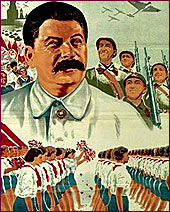 Before
his death, Lenin came to regard the flaws in Stalin's personality
and conduct as political liabilities. In his political "testament"
Lenin doubted whether the party's general secretary would
use his great power with sufficient caution. He also attacked
Stalin as being "too rude"
and called for his removal. Luck and adroit maneuvering enabled
Stalin to suppress Lenin's testament. By skillful manipulation
and clever sloganeering, but especially by interpreting Lenin's
precepts to a new generation coming of age in the 1920s, Stalin
bested all his rivals. By his 50th birthday (1929), Stalin
had cemented his position as Lenin's recognized successor
and entrenched his power as sole leader of the Soviet Union. Before
his death, Lenin came to regard the flaws in Stalin's personality
and conduct as political liabilities. In his political "testament"
Lenin doubted whether the party's general secretary would
use his great power with sufficient caution. He also attacked
Stalin as being "too rude"
and called for his removal. Luck and adroit maneuvering enabled
Stalin to suppress Lenin's testament. By skillful manipulation
and clever sloganeering, but especially by interpreting Lenin's
precepts to a new generation coming of age in the 1920s, Stalin
bested all his rivals. By his 50th birthday (1929), Stalin
had cemented his position as Lenin's recognized successor
and entrenched his power as sole leader of the Soviet Union.

After the 1924 death of Lenin, Trotsky and Stalin vied
for power. Victorious over Trotsky at the end of the
1920s, Stalin carried out massive industrialization efforts,
the collectivization of agriculture, and extensive
purges of the party and military. His policies directly resulted
in the deaths of millions of Soviet citizens.
|
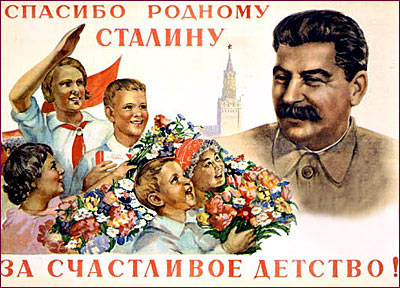
Soviet poster - "Thank you dear
Stalin for a Happy Childhood!"
|
In the mid-1930s Stalin launched
a major campaign of political terror. The purges, arrests,
and deportations to labor camps touched virtually every family.
Former rivals Zinovyev, Kamenev, and Bukharin admitted to crimes
against the state in show trials and were sentenced to death.
Untold numbers of party, industry, and military leaders disappeared
during the "Great Terror," making way for a rising
generation that included such leaders as Nikita Khrushchev and
Leonid Brezhnev. Fear instilled by a political secret police
formed an essential part of the system called Stalinism.
 |
|
|
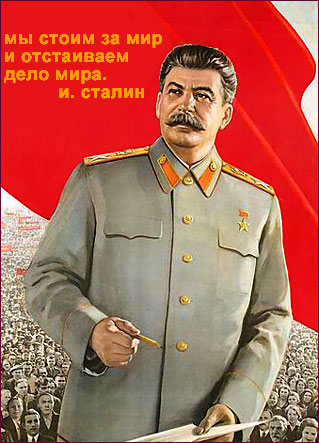
"We are for peace. Stalin."
Soviet poster from 1952.
|

|
|
 In
part because the purges stripped the military of its leadership,
the Soviet Union suffered greatly in World War II. Stalin
personally directed the war against Nazi Germany. By rallying
the people, and by his willingness to make great human sacrifices,
he turned the tide against the Germans, notably at the Battle
of Stalingrad. Stalin participated in the Allies' meetings
at Tehran (1943), Yalta (1945), and Potsdam (1945), where
he obtained recognition of a Soviet sphere of influence in
Eastern Europe, and after the war he extended Communist domination
over most of the countries liberated by the Soviet armies.
His single-minded determination to prevent yet another devastating
assault on the USSR from the West had much to do with the
growth of the cold war. In
part because the purges stripped the military of its leadership,
the Soviet Union suffered greatly in World War II. Stalin
personally directed the war against Nazi Germany. By rallying
the people, and by his willingness to make great human sacrifices,
he turned the tide against the Germans, notably at the Battle
of Stalingrad. Stalin participated in the Allies' meetings
at Tehran (1943), Yalta (1945), and Potsdam (1945), where
he obtained recognition of a Soviet sphere of influence in
Eastern Europe, and after the war he extended Communist domination
over most of the countries liberated by the Soviet armies.
His single-minded determination to prevent yet another devastating
assault on the USSR from the West had much to do with the
growth of the cold war.
In his last years, increasingly paranoid and physically weak,
Stalin apparently was about to start another purge.
In January 1953 he ordered the arrest of many Moscow
doctors, mostly Jews, charging them with medical assassinations.
The so-called Doctors' Plot seemed to herald a return to the
1930s, but Stalin's sudden death on March 5, 1953, in Moscow
forestalled another bloodbath.
Since the end of his era, Stalin's time in power has
been furiously debated and his motives have been extremely
controversial.
Stalin sacrificed friends and family to power. He was
not a very affectionate man and revolutionary traits hardened
him even more. He had four simple rules of success in life
to achieve desired end men must be discarded when they are
no longer useful, alienators are made to be broken, any method
is justified if it helps to achieve the ultimate goal and,
ideas have no existence under the chariot of power. At the
funeral of his first wife, Stalin commented that any warm
feelings he had for people died along with her, for she was
the only person who was able to melt his heart.
At his death in 1953, Joseph Stalin joined Lenin
in the vault of the Mausoleum, but in 1961, Stalin's body
was removed and buried simply next to the Kremlin wall next
to other Communist leaders.
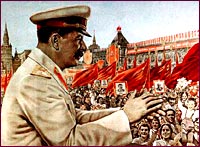 Within
a few weeks of Stalin's death, the Soviet leaders began a
campaign to whittle down Stalin's reputation, which culminated
in a devastating attack by Nikita Khrushchev at the 20th party
congress in February 1956. By that time virtually every country
in the Communist bloc was in turmoil. Within
a few weeks of Stalin's death, the Soviet leaders began a
campaign to whittle down Stalin's reputation, which culminated
in a devastating attack by Nikita Khrushchev at the 20th party
congress in February 1956. By that time virtually every country
in the Communist bloc was in turmoil.
Stalin's method of personal rule was replaced by group
rule and more orderly processes of government, the terror
apparatus was largely dismantled, the economy was notably
modernized, and foreign policy was conducted with much greater
diplomatic initiative and flexibility. But the Soviet leadership
continued to cling tenaciously to the authoritarian system
of party supremacy that shapes every aspect of life in the
Soviet Union and to Soviet dominance over the Communist countries
on its western borders.
|

|
Links
More about Stalin on
www.bbc.com, on www.cnn.com,
Stalin
Reference Archive, Daily
Life in Stalin's Russia, Stalin-Era
Research and Archives (in English)
|
|
|



